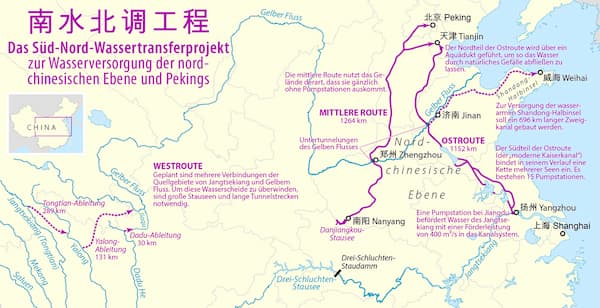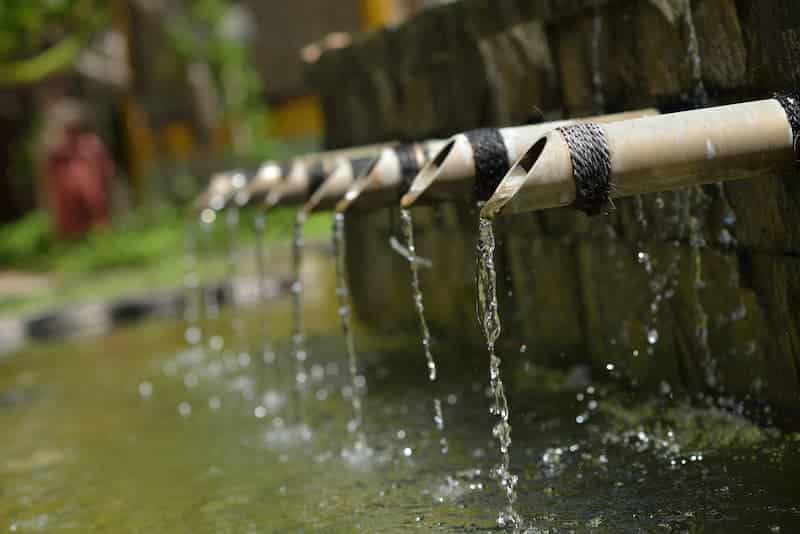China lacks drinking water especially in the northern provinces. The scarcity will be more severe over the coming years. The failed BRI project aimed at water supply from Lake Baikal would only have solved part of the water shortage issue. The remaining part is to be addressed by China’s massive South-to-North Water Diversion Project. As a result, water supply remains a significant Achilles' heel for China.
Water scarcity is unevenly distributed across China ...
In fact, China has plenty of water, boasting the world's 5th largest freshwater reserves. However, the geography and economy of China are effectively divided into two equal parts by the east-west flowing Yangtze River. North of this river, the climate is relatively dry and cold, while south of the Yangtze, there is a subtropical climate with abundant rainfall and reserves. Only 4% of the country’s freshwater reserves are located in the northern provinces, where 25% of the population lives.
This uneven distribution has led to critical water shortages in several major cities. The UN defines water scarcity as a situation where there is less than 2,000 m³ per person. In cities like Beijing and Tianjin, the figure is as low as 122 to 162 m³ per person, and in Shanghai, 252 m³ per person.
... and is Exacerbated by Pollution As a result, many groundwater reserves have become so polluted that the water requires expensive purificationbefore it can be used for agriculture or drinking. This is the case for more than half of the water around Beijing. Similarly, studies show that up to 80% of China’s wellsused by agriculture, factories, and households are unsuitable for drinking water for both humans and animals.
China’s Ministry of Natural Resources therefore expects that water scarcity could lead to survival crises in several areas before 2030.
China is therefore Building the World’s Largest Water Diversion Project
Water scarcity was one of the main reasons behind the BRI project with Russia for a freshwater pipeline from Lake Baikal. The project was officially scrapped in 2017. However, fundamentally, the project would have only supplemented and relieved China’s original South-to-North Water Diversion Project, the largest of its kind in the world.
The project is based on ideas discussed by Mao as far back as 1952 and was finally approved in 2003. The project will span five decades and aims to transport 44.8 cubic kilometers of freshwater each year from the Yangtze River in southern China to the northern provinces. By 2014, $79 billion had already been spent on the project. This amount is equivalent to about 20 Great Belt Bridges, and China typically builds at significantly lower costs than Denmark. An additional $100-150 billion is expected to be needed to complete the project by 2050.
The project consists of three main pipelines. These are either constructed as open covered waterways or through extensive tunnels and pipelines, often passing through mountains or underground to ensure the necessary gradient, much like Roman aqueducts.
The project also places demands on the water sources, particularly in the Himalayas (West route). This increases India’s concern about whether it could affect their water supply to the Brahmaputra River.
But the project is risky
Additionally, the project will force 350,000 Chinese people to relocate. This number is significant enough to pose a risk of substantial social unrest. For this reason, among others, both Hubei and Sichuan provinces are officially opposed to the project. It is rare for opposition to central projects to be expressed (so) publicly.
The opposition also stems from the fact that the rivers from which the water is taken are drying up. Climate change exacerbates the problem. Therefore, several provinces risk experiencing (periodic) water shortages in the future, leading to potential food shortages.
Finally, the project risks merely transporting polluted water from the south to the north, as the rivers feeding the system continue to receive large quantities of untreated wastewater.
This is why the BRI project from Lake Baikal from 2016/2017 was considered a necessary buffer. China still lacks such a buffer. Access to the Tumen or Ussuri rivers could perhaps be a solution here.
See the next blog post


